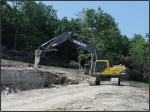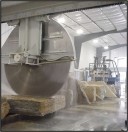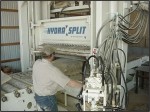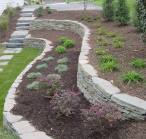I’m going to take off my gardening hat today and address a landscape topic. Rock walls, stepping stones, stone steps, boulders, and decorative gravels are an integral part of our business, and when I first followed the supply chain from the companies that Meadows Farms purchases stone from I was  fascinated. I doubt that many people understand the path a rock takes from quarry to the backyard.
fascinated. I doubt that many people understand the path a rock takes from quarry to the backyard.
 In the landscape business we utilize quarried and collected stone. Collected stone is picked up and used in the form it was found. Most of the boulders we use are collected, although they are often buried. Some landscape gravels are collected, and fieldstone is generally collected from walls where farmers piled it at the margins of their fields. It’s hard for me to imagine someone stacking a ton and a half of stone on a pallet for a few bucks, but that’s what they do.
In the landscape business we utilize quarried and collected stone. Collected stone is picked up and used in the form it was found. Most of the boulders we use are collected, although they are often buried. Some landscape gravels are collected, and fieldstone is generally collected from walls where farmers piled it at the margins of their fields. It’s hard for me to imagine someone stacking a ton and a half of stone on a pallet for a few bucks, but that’s what they do.
Quarried stone is usually more consistent quality because it is cut or snapped to the desired size, and then the usable stone is selected. The quarry photos show the stone being broken into slabs the size of cars.

The slabs are then cut into a smaller, more usable size. The blade on the saw in this photo is more than ten feet across. There is a constant stream of water that cools the blade. This saw shop at Semco Distributing has a handful of computer controlled saws of various sizes.

Many of the rocks we use for steps and walls are split into smaller sizes with a hydraulic splitter. The slabs of stone are set on a conveyor then pulled under the splitter. The hydraulic jaws apply pressure from top and bottom, and the rock splits with a pop. The face of the rock is thusly called a “split face”. The rock is then graded by size, palletized, and delivered. The limestone quarry in these pictures is located in Missouri, so the trucking cost is significant.

Meadows Farms stocks stone in its garden centers in full ton-and-a-half pallets, and half pallets that can be safely loaded on pickup trucks. Many homeowners are capable of building stone walls as a do-it-yourself project. A sore back and a few squashed fingers are likely to follow, but the flat stones are fairly easy to construct into a decent wall.
 However, our stone masons take the same stones and shape them with rock hammers to create something that few amateurs are capable of. Their beautiful creations will last for many years.
However, our stone masons take the same stones and shape them with rock hammers to create something that few amateurs are capable of. Their beautiful creations will last for many years.
Hi …. do you work with any of the precast concrete lattice pavers for walkways without steps for a slight hill? Thinking of this sorta walkway for getting mower up and down hill in back yard (mower stored in shed at higher level than rest of yard). It’ll create a pemeable walkway.
See: http://www.icpi.org/techspecs/index.cfm?id=17&tech=08
In my online search, I saw “Drivable Grass” @ http://www.soilretention.com/drivablegrass.html
Thanks, Greg
There are a number of styles of pavers available that are water permeable or that allow grass to grow between the pavers. I have doubts that grass will grow long term through gaps in concrete paving since the concrete is likely to wick moisture from the soil, but there are plenty of options to choose from.